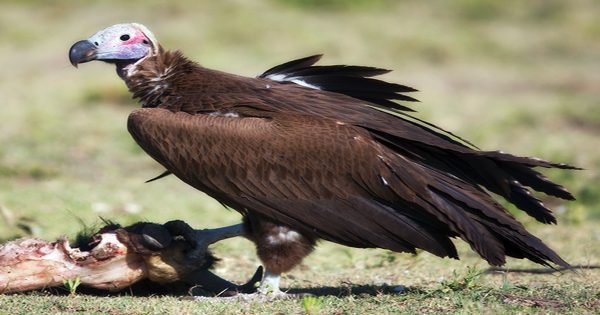The lappet-faced vulture or Nubian Vulture (Torgos tracheliotos) is an African Old-World vulture that belongs to the Accipitriformes bird order, which also includes eagles, kites, buzzards, and hawks. The genus Torgos has only one member. It is not closely related to the superficially similar New World vultures, and it lacks some of that group’s members’ excellent sense of smell. It has mostly dark feathers, and its bare pink head and wide, fleshy folds of skin on the sides of its neck make it easy to spot. The bird is primarily a scavenger, relying on large carcasses or their remains for food. It is also known to hunt, most likely taking small reptiles, fish, birds, and rodents, and has been seen hunting flamingo chicks in groups. The lappet-faced vulture was once thought to be monotypic, but it has now been split into two subspecies. The nominated race can be found all over Africa. This imposing, broad-winged bird has a huge, powerful beak capable of tearing the hides, tendons, and any other coarse tissue from prey that other scavengers can find too tough. The large size, bare pink head, and fleshy folds of skin on each side of the bird’s neck, which gives the bird its common name, make this species easily identifiable. The scientific name “Cartilige-eared Vulture” is Greek. The lappet-faced vulture is one of Africa’s most dangerous species. It has one of the toughest beaks, and due to its ability to rip off flesh, tendons, and ligaments that are too tough for smaller scavengers, it normally arrives last to the carcass. They may, in reality, strip a small antelope carcass to the bone in less than 20 minutes. Smaller vultures are often scared away or stolen by larger vultures due to their intimidating size. These vultures don’t just consume carrion; they’ve been seen sitting near termite mounds or locust nests, eating the insects as they emerge from their holes. It is not closely related to the superficially similar New World vultures, and it lacks some of that group’s members’ excellent sense of smell. The Lappet-faced vulture can be found all over Africa and the Middle East, from the southern Sahara to the Sahel, East Africa to the country’s center, and as far north as northern South Africa. This vulture can be found in dry savannah, desert, or semi-arid areas with only short grass, thorn bushes, and sparse trees for most of its range, as well as on open mountain slopes as high as 4,500 meters above sea level. While open habitat is ideal for foraging, trees are also essential for nesting and roosting, with thorny species such as acacia, terminalia, and balanites being preferred.

The vultures with the lappet-faced heads stand about 39 inches (1 meter) tall. The width of their outstretched wings can reach 8.9 feet (2.7 meters). They can reach a weight of up to 20 pounds (9 kilograms). The majority of a lappet-faced vulture’s feathers are black or brown. The white feathers on the thighs are a nice touch. The skin of the featherless head is pink or reddish. The wide skin folds, or lappets, that hang along the sides of the bird’s head give it its name. The wing chord is 71.5–82.5 cm (28.1–32.5 in), the tail is 33–36 cm (13–14 in), and the tarsus is 12.2–15 cm (4.8–5.9 in) among the normal dimensions. The bill is one of the largest of any accipitrid, measuring up to 10 cm (3.9 in) long and 5 cm (2.0 in) deep, though its culmen length of 7.2 cm (2.8 in) is slightly shorter than that of the cinereous vulture. It has a bald head, like many vultures. The pink (sometimes reddish) coloration is a distinctive feature. Since a feathered head would become splattered with blood and other fluids, keeping it clean would be difficult. Vultures with lappet-faced faces travel great distances in search of food. They eat mainly dead meat that they find, much like other vultures. They can pierce even the toughest animal skin with their arched beaks. In reality, smaller scavengers often rely on lappet-faced vultures to dismantle carcasses. The smaller scavengers, on the other hand, would have to wait until the lappet-faced vultures have finished feeding. While lapwing vultures are poor hunters, they can capture small live prey if no other food is available. They usually live in pairs and congregate in flocks of up to 50 vultures and other raptors near carrion or water. They outnumber all other birds of prey near the food source, performing displays such as bounding attacks, but they spend more time doing these displays than eating, returning to the carcass later. These birds break tough skin and tendons with their powerful bills. They’ll even scavenge food from other raptors feeding nearby. They are also the first to eat because they are better suited to tearing up the skin to begin the feeding process. This vulture is usually quiet, but it grunts, hisses, growls, and yelps when it is near a feeding site. Except for populations in West Africa, which migrate north during the rainy season and south during the dry season, it does not migrate. The lappet-faced vulture is a scavenging bird that feeds primarily on animal carcasses that it discovers by sight or by observing other vultures. The lappet-faced vultures, maybe more than any other vulture, are known to prey on young and vulnerable living creatures, as well as raiding other birds’ nests. Lappet-faces have been recorded to kill Lesser Flamingos and other birds in this manner in the region. A lappet-faced vulture’s home range is usually 8 to 15 kilometers (5.0 to 9.3 mi). At large carcasses or watering holes, groups of up to 50 Lappet-faces can congregate, but usually, only one to seven turn upper carcass. At the top of a thorny tree, a pair constructs a large, bulky, flat nest made of small sticks and lined with dry grasses. One egg is laid, and both parents incubate it for 7 to 8 weeks. But for a gray head and neck, the newborn chick is fully coated in white down. It has a gray second layer of down. When the chick is 125 to 135 days old, it leaves the nest and remains dependent on its parents for a long time. They don’t normally breed until they’re about 6 years old. Several threats face lappet-faced vultures. Many birds are killed in South Africa by poison used by farmers to destroy predators such as jackals. Vultures are often shot by farmers who feel the birds pose a threat to their livestock. Furthermore, several vultures are killed as they crash into overhead power lines.
















